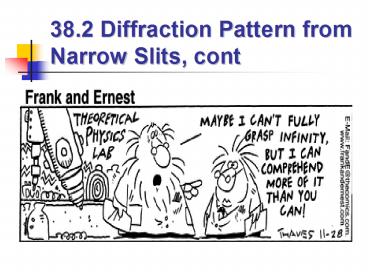38.2 Diffraction Pattern from Narrow Slits, cont - PowerPoint PPT Presentation
1 / 19
Title:
38.2 Diffraction Pattern from Narrow Slits, cont
Description:
Left: Earth-based telescope is blurred ... and Telescope Resolution ... The Keck telescope at Mauna Kea, Hawaii, has an affective diameter of 10 m. Find ... – PowerPoint PPT presentation
Number of Views:201
Avg rating:3.0/5.0
Title: 38.2 Diffraction Pattern from Narrow Slits, cont
1
38.2 Diffraction Pattern from Narrow Slits, cont
2
Intensity of Two-Slit Diffraction Patterns
- When more than one slit is present, consideration
must be made of - The diffraction patterns due to individual slits
- The interference due to the wave coming from
different slits - The single-slit diffraction pattern will act as
an envelope for a two-slit interference pattern
3
Intensity of Two-Slit Diffraction Patterns,
Equation
- To determine the maximum intensity
- (38.6)
- The factor in the square brackets represents the
single-slit diffraction pattern - This acts as the envelope
- The two-slit interference term is the cos2 term
4
Intensity of Two-Slit Diffraction Patterns, Graph
of Pattern
- The broken blue line is the diffraction pattern
- The red-brown curve shows the cos2 term
- This term, by itself, would result in peaks with
all the same heights - The uneven heights result from the diffraction
term (square brackets in the equation)
5
Two-Slit Diffraction Patterns, Maxima and Minima
- To find which interference maximum coincides with
the first diffraction minimum - (38.7)
- The conditions for the first interference
maximum - d sin ? m?
- The conditions for the first diffraction minimum
- a sin ? ?
6
Example 38.3 Two-Slit Diffraction (Quiz 38.3)
- Using the previous figure, make a sketch of the
combined diffraction and interference pattern for
650-nm light waves striking two 3.0-?m slits
located 9.0-?m apart. - First case d 18.0-?m, a 3.0-?m, so m 6
- In our case m 9/3 3.
- The 3rd interference maximum coincides with the
1st diffraction minimum
7
Active Figure 38.11
(SLIDESHOW MODE ONLY)
8
38.3 Resolution
- The ability of optical systems to distinguish
between closely spaced objects is limited because
of the wave nature of light - If two sources are far enough apart to keep their
central maxima from overlapping, their images can
be distinguished - The images are said to be resolved
- If the two sources are close together, the two
central maxima overlap and the images are not
resolved
9
Resolved Images, Example
- The images are resolved
- The images are far enough apart to keep their
central maxima from overlapping - The angle subtended by the sources at the slit is
large enough for the diffraction patterns to be
distinguishable
10
Images Not Resolved, Example
- The images are not resolved
- The sources are so close together that their
central maxima do overlap - The angle subtended by the sources is so small
that their diffraction patterns overlap
11
Rayleighs Criterion
- When the central maximum of one image falls on
the first minimum of another image, the images
are said to be just resolved - This limiting condition of resolution is called
Rayleighs criterion
12
Rayleighs Criterion, Equation
- The angle of separation, ?min, is the angle
subtended by the sources for which the images are
just resolved - Since ? small and sin ? ?
- Therefore, the limiting angle (radians) of
resolution for a slit of width a is - (38.8)
- To be resolved, the angle subtended by the two
sources must be greater than ?min
13
Circular Apertures
- Many optical systems use circular apertures
rather than slits - The diffraction pattern of a circular aperture
consists of a central bright disk surrounded by
progressively fainter bright and dark rings - The limiting angle of resolution of the circular
aperture is - (38.9)
- D is the diameter of the aperture
14
Circular Apertures, Well Resolved
- The sources are far apart
- The images are well resolved
- The solid curves are the individual diffraction
patterns - The dashed lines are the resultant pattern
15
Circular Apertures, Just Resolved
- The sources are separated by an angle that
satisfies Rayleighs criterion - The images are just resolved
- The solid curves are the individual diffraction
patterns - The dashed lines are the resultant pattern
16
Circular Apertures, Not Resolved
- The sources are close together
- The images are unresolved
- The solid curves are the individual diffraction
patterns - The dashed lines are the resultant pattern
17
Resolution, Example
- Pluto and its moon, Charon
- Left Earth-based telescope is blurred
- Right Hubble Space Telescope clearly resolves
the two objects
18
Example 38.4 Eye and Telescope Resolution
- Estimate ?min for the human eye. Using a light
of 500 nm and the daytime average diameter for a
human pupil of 2.0 mm - The Keck telescope at Mauna Kea, Hawaii, has an
affective diameter of 10 m. Find the resolution
?min for 600-nm light
19
Material for the Final Exam
- Examples to Read!!!
- Example 38.3 (Page 1216)
- Homework to be solved in Class!!!
- Problems 12, 21































